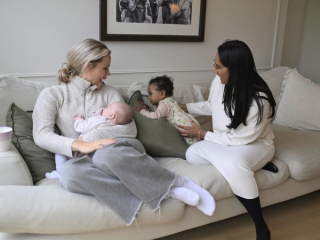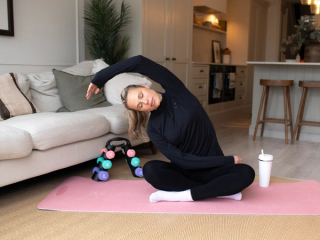
- Home
- Advice And Support
- Newborn
- Postnatal Care
- How To Safely Return To Exercise After Birth
How to safely return to exercise after birth
Whether you are an avid gym goer, a seasoned runner or a complete beginner, returning to exercise after pregnancy can be challenging. Our bodies go through a lot during pregnancy and birth, and you need to take a gentle approach to returning to exercise after giving birth.
Whether you are an avid gym goer, a seasoned runner or a complete beginner, returning to exercise after pregnancy can be challenging. Our bodies go through a lot during pregnancy and birth, and no matter how positive your birth was, your body will need to recover. Keep that in the forefront of your mind - your body needs to recover and it will lead the way.
Many women can find the return to exercise frustrating to start with, especially if they deemed themselves to be fit and strong all the way up until the birth. It is vital that we get the beginning part of this rehab right in order to create a strong base on which to build. I have worked with many women who decided to go out on a 10k run just weeks after giving birth – with no prior rehab – and then they came to me for help because their bodies did not like it.
It is widely recommended that women wait until around 6 weeks before starting exercise...
and I have to say that I agree with this; however, it doesn’t mean that from week 1 – 6 you should sit on the sofa and do nothing. Yes, you need to prioritise rest, but from as early as you feel comfortable in doing so, you can start to reintroduce your pelvic floor exercises and core breathing. It is sensible to begin reconnecting your brain to those all-important core and pelvic floor muscles again. These can be done in a seated or lying position and don’t impact rest.
When you feel ready, short walks with or without the buggy are a great way to get the body moving again and over time you can steadily build up the distance and time spent walking. An added bonus is that babies often love to sleep on-the-go, so you can keep your baby snoozing while you get moving. That and gentle stretching will be plenty for you to do in the first 6 weeks while you allow your body the time it needs to do some natural rehabilitation, for your organs to move back to their original positions as the uterus contracts, as well as allow time for scars to heal from episiotomies and/or c sections.
Pilates
When you get the all clear from your doctor or physio, I would recommend starting with Pilates-based exercise, whether that’s going to a post-natal Pilates class, working with a PT, doing a class at home, or just incorporating some bodyweight exercises focusing on the breath and alignment. Pilates is wonderful for easing the body back into exercise in a gentle way. It is kind to your joints and has a strong focus on moving in the right way rather than just moving, and that’s exactly what we need after our bodies have been through pregnancy.
Weights
If you are someone who likes lifting weights then you can start with light weights once you feel that you are mastering the bodyweight movements and your body feels happy with them, during and afterwards. You need to listen to your body to determine how fast and how much to increase the weights, as there is certainly no one size fits all here. Don’t make the mistake of lifting weights as heavy as you did pre pregnancy to begin with; your body will need to build up to that again.
Running
I know there will be some keen runners reading this, so I wanted to make sure I touched on it. However tempting it may be, please don’t lace up those running trainers just yet. In order to get back to running it’s important that you prepare your body for it. The time frame will depend on how much you ran before or even during pregnancy, but also on how your birth went, what kind of birth you had, how your body is recovering etc.
Physios have released updated guidance over the last few years that suggest that the best time to get back to running after birth is 6 months. Don’t panic. I know this may seem like a long time to many of you, but this is merely a guide and everyone is different. But what it is suggesting is that you need to put aside some serious time to rehabilitate your body and get it ready for running.
Your body is carrying those pregnancy hormones for a while after you give birth, and even longer if you choose to breastfeed, so you still need to be mindful of this when you introduce impact work back into your workouts. Building strength in your muscles to support joints such as hips, knees, ankles is vital for returning to running. There are plenty of exercises that are great for building strength – for example, landing on one leg, rebounding from one to the other – so make sure to start adding them into your workouts before you hit the pavement.
Whatever it is that you’d like to get back to, or start for the first time, after birth the main thing to remember is that it doesn’t happen overnight. Even if you were an advanced athlete before pregnancy, it will still take some time to build up your strength and fitness to get you back there, but you absolutely will, so be patient with yourself and don’t jump in at the deep end.
Advice & tips

Want to read more? Join the HiPP BabyClub for full access to this article.
As a BabyClub member, you'll get access to a range of exclusive benefits, including:
Monthly competitions
Discounts from our Partners
Expert advice tailored to your little one's age
Weaning recipes
HiPP shop discounts*
*10% off HiPP's online shop does not apply to our First Infant, Anti-Reflux or Comfort Formula Milk.
Important notice: Breastfeeding is best. Follow on milk should only be used as part of a mixed diet from 6 months. Talk to a healthcare professional.
















